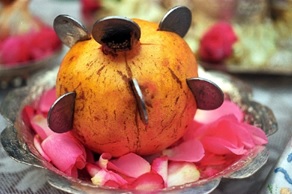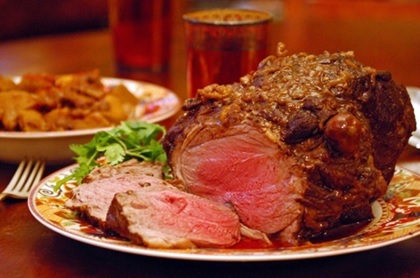With Persephone’s return, comes the spring. But there’s a catch. Starving and unimpressed with Hades’ attempts to woo her, Persephone ate six pomegranate seeds while in the underworld. Those six seeds require her to return to the underworld during pomegranate season (roughly September through February in the Northern Hemisphere). Repeated year after year, Persephone’s place creates our annual seasonal cycle of death in the fall and winter and rebirth in the spring.
That is the ancient Greek myth that many of us learned as children, but nearly every culture in which pomegranates are traditionally enjoyed has incorporated them into their myths and symbols. Pomegranates have been used to conjure everything from lust and sexual abandon, to fertility and prosperity, to blood and national identity, and even, as in Persephone’s case, death and rebirth. Pomegranates have been with us since the beginnings of civilization and their image has meanings that span the entirety of human existence.
Pomegranate symbolism
The pomegranate’s many seeds have led to its use as a symbol for fertility and fecundity in a wide variety of cultures from ancient Persia to Japan. Newly married couples or married women trying to conceive often ate pomegranates or drank the fruit’s juice to increase the chances of a healthy birth. Some North African Berber women also use the seeds in divination rituals to predict the number of children they will bear in their lifetimes.

Pomegranates with coins inserted are also given as pre-nuptial gifts from the groom to the bride in the South Asian Parsi culture to symbolize fertility and prosperity in the marriage. Pomegranates prepared with coins are also used on the Zoroastrian Nowruz table for longevity and good health in the coming year.
Persian epic hero, Isfandyar was said to have enjoyed pomegranate juice before battle to make himself and his armies invincible. This practice was also followed by the Uzbek-born emperor Timur (Tamerlane) as he swept across central and western Asia in the 13th century. Today, a large stone vessel stands outside of Timur’s tomb in Samarkand to commemorate the practice.
The Quran also states that pomegranates grow in the garden of paradise, and some religious scholars believe that it was the pomegranate, not the apple, that was the fruit of temptation in Judeo-Christian scripture.
Origins and cultivation
Domesticated in ancient Mesopotamia by the third millennium B.C. (and possibly well before), pomegranates have also been recovered from later Bronze Age archaeological sites in Israel and Cyprus. The Egyptians had orchards full of pomegranate trees by the time of Hatshepsut’s rule (1479-1458 B.C.), and the Phoenicians were an important force in spreading the fruit across North Africa and into Southern Europe as their seaward empire grew toward Carthage and beyond. It is just this connection that lies behind the pomegranate’s original Latin name, Punicum malum, or Punic apple. Pomegranates made their way to China by the first few centuries of the Common Era, and from there onto Japan and Korea, where they are today widespread.
As the fruit has been traded and adopted, hundreds of cultivars have been created that vary in fruit and seed color, sweetness, acidity and astringency. The fruits themselves vary in color from a creamy off-white to yellow; to the familiar shades of pink and red; to a dark, almost-black purple. Seeds (sometimes called arils) also vary in color from crimson to a clearish-white color. Cultivars have also been bred to allow them to grow in extreme weather conditions, such as the pomegranates in China’s far western Xingjian province, which regularly endure drought and winter temperatures as low minus-40 F.
Pomegranate’s culinary uses
Throughout western Asia and the Caucasus, pomegranate juice and syrup are used extensively to bring sweet and sour flavors to meat and vegetables. Meats are marinated in the juice, or sauces are prepared to use at the grill or table. Additionally, pomegranate syrup is used in the preparation of mixed condiments, often using walnuts or roasted peppers and garlic to complement a wide variety of dishes. Some Iranians and Azeris also use pomegranates as the center of a savory soup. Pomegranate seeds are also used to stuff vegetables and fish, and the juice is used in place of vinegar to pickle vegetables, especially garlic and pearl onions.

On the subcontinent and in parts of the Himalaya, pomegranate seeds are used as souring and flavoring agents in curries and chutneys. In central Asia, juice and syrup are used much as in western Asia and the Caucasus, but pomegranate seeds are also used in a wide variety of rice and millet pilafs. Mongolia and western China use pomegranate juice in lamb stews along with cinnamon, but sometimes add rice vinegar or asafetida to lend a more eastern Asian flavor to them.
Pomegranate seeds also are used in a variety of liquors throughout Asia. In the Caucasus, they are used in mixed fruit wines along with grapes or cherries, and in eastern Asia they are used to flavor local grain-based homebrews and other medicinal preparations.
I created this lamb recipe by adapting a traditional Persian fesenjān recipe originally used on fowl. Instead of roasting the meat, I braise and add butternut squash for a nearly perfect one-pot meal.
(Words and photos of: Pomegranate Ripening on the Tree and Lamb in a Pomegranate-Cardamom Sauce by Laura Kelley. Photo of “Parsi Pomegranate with Coins” by Hemant Mehta for the UNESCO Parzor Project, Parzor Foundation (unescoparzor.com))
(Originally published in Zester Daily.)

